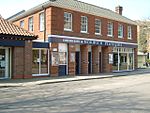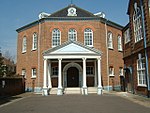St George's Church, Colegate, Norwich
15th-century church buildings in EnglandChurch of England church buildings in NorwichGrade I listed churches in Norfolk

St George's Church, Colegate, Norwich is a Grade I listed parish church in the Church of England in Norwich.
Excerpt from the Wikipedia article St George's Church, Colegate, Norwich (License: CC BY-SA 3.0, Authors, Images).St George's Church, Colegate, Norwich
Saint George's Street, Norwich New Catton
Geographical coordinates (GPS) Address Website External links Nearby Places Show on map
Geographical coordinates (GPS)
| Latitude | Longitude |
|---|---|
| N 52.633197222222 ° | E 1.2939 ° |
Address
Saint George
Saint George's Street
NR3 1DA Norwich, New Catton
England, United Kingdom
Open on Google Maps











